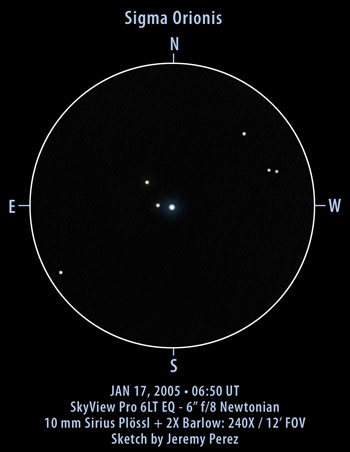
October 12, 2006: To help provide a consistent style for my double star sketches, the above sketch is a digital update to the original sketch.

Observation Notes:
A neat multiple star area. There was a triple star at center with a blue component on the west side. The northeast component almost looked orangeish by comparison, but it's really white. Another double is on the west edge of the view.
| Subject | Sigma Orionis (48 Ori / STF 762) |
| Classification | Multiple Star |
| Position | Orion [RA: 05:39 / Dec: -02:36]* |
| Separation* | 12.9" / 43" |
| Magnitudes* | 4.0 / 7.5 / 6.5 |
| Position Angle* | 84° / 61° |
| Date/Time | 01/16/05 - 11:50 PM |
| Observing Loc. | Flagstaff, AZ - Home |
| Instrument | Orion SVP 6LT Reflector (150 mm dia./1200 mm F/L) |
| Eyepieces/Mag. | 10 mm + 2X Barlow (240X) |
| Conditions | Patchy high clouds, cool (34°F), 1st quarter Moon |
| Seeing | 5/10 |
| Transparency | Mag 4.9 NELM |
*Based on published data.





I really love your website and have lots of fun making reference to your double star observations. I am currently finishing up observations for the Astro League 100 binary List. A lot of times my estimation of north is incorrect. I use a Meade 12mm Astrometric illuminted eyepiece and do the drift method. Sometimes I have to subtract/add 90º or 180º. There doesn't seem to be any rule to follow.
Hi Stephen,
The basics I use: with tracking turned off, stars will drift west (PA 270°). Whether North is clockwise or counterclockwise will depend on the telescope. A refractor with a mirror diagonal (1 reflection) will put north clockwise from west. A Newtonian (2 reflections) will put north counter-clockwise from west. The best way to find out is to let stars drift and mark that point west, and then nudge the scope northward--stars will enter on the north side of the field. Once you note the relationship, you will automatically know north any time you mark the westward drift in your drawing/notes.
Here is a link to a protractor setup I put together to help me keep things straight when measuring with the astrometric eyepiece: Measuring Double Stars.
Let me know if that was what you were looking for.
Clear skies,
Jeremy